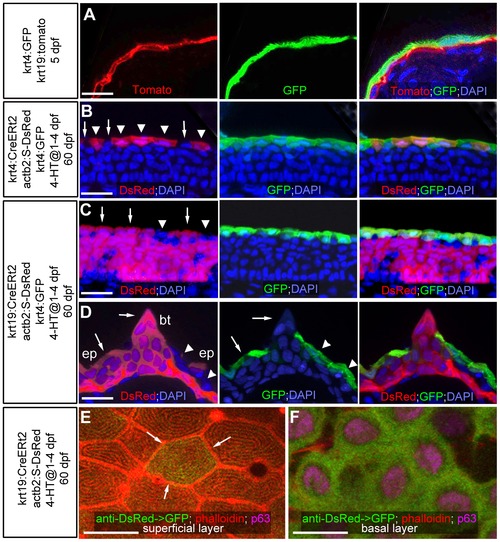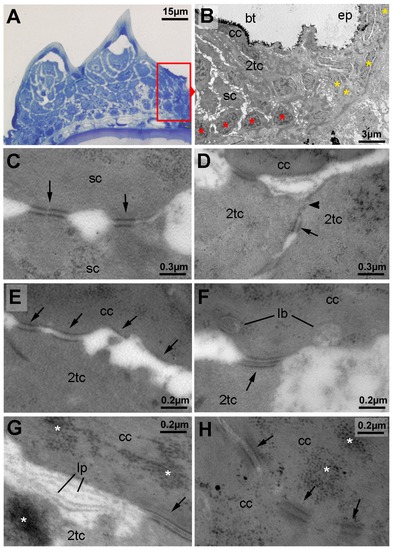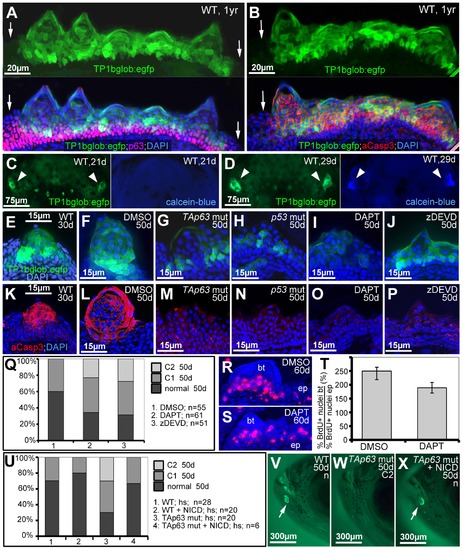- Title
-
p53 and TAp63 promote keratinocyte proliferation and differentiation in breeding tubercles of the zebrafish
- Authors
- Fischer, B., Metzger, M., Richardson, R., Knyphausen, P., Ramezani, T., Franzen, R., Schmelzer, E., Bloch, W., Carney, T.J., and Hammerschmidt, M.
- Source
- Full text @ PLoS Genet.
|
Transgenic lineage tracing of enveloping layer cells and basal keratinocytes in regular epidermis and breeding tubercles. (A?D) show transgene-encoded GFP and Tomato/dsRed fluorescence; transverse cryosections stained with DAPI; red channel on the left, green channel in the middle, merged channels on the right; (A) larva at 5 dpf; (B?D) juvenile fish at 60 dpf; (B,C) regular epidermis; (D) breeding tubercle on lower jaw. In (B?D), superficial cells deriving from the embryonic enveloping layer (EVL) are indicated with arrowheads, superficial cells deriving from the embryonic basal layer with arrows. (A) At 5 dpf, krt4-driven transgene expression is confined to EVL (in green), krt19-driven transgene expression to basal layer (in red). (B,C) At 60 dpf, derivatives of EVL cells (red; B) and basal keratinocytes (red, C) are present in the outer layer of regular epidermis, intermixed with unlabelled cells, but expressing the same marker gene (tg(krt4:GFP) in green). (D) At 60 dpf, the breeding tubercle (bt), including its superficial layer, consists solely of derivatives of basal cells (in red). However, superficial cells lack expression of krt4:GFP (green). (E,F) anti-DsRed (in green) and anti-p63 (in pink) immunofluorescences, combined with phalloidin-staining of cytoskeletal actin (in red); confocal images of superficial (E) and basal layer (F) of regular epidermis; 60 dpf. A clone of labelled basal cells (F; green) has given rise to a single superficial cell (marked by arrows in E), which displays the same microridge pattern as non-labelled neighbours. Scale bars: 20 μm (A?D), 10 μm (E). Abbreviations: 4-HT, 4-hydroxytamoxifen; act2b:S-DsRed, actb2:loxP-STOP-loxP-dsREDEx; bt, breeding tubercle; ep, regular epidermis. EXPRESSION / LABELING:
|
|
Breeding tubercle keratinocytes undergo more advanced keratinization. All images show breeding tubercles in wild-type zebrafish of one year of age; (A?E) views on body surface; (F?L) transverse sections through lower jaw. (A) Scanning electron micrograph (SEM) of the lower jaw; breeding tubercles are indicated by arrowheads. (B,C) Nomarski micrographs of pectoral fins of male (B) and female (C) fish. Bony rays (lepidotrichia) are marked (le). (D,E) SEM images of breeding tubercles (bt) on a male pectoral fin. (F) Trichrome (AFOG) staining; breeding tubercles consist of more cell layers than adjacent epidermis (arrow). The tubercle cap layer (cl) is stained in lighter red, resulting from its stronger keratinization. (G?L) GFP fluorescence of tg(krt4:GFP) line (G, green) and pan-type II Keratin immunofluorescence (H; red), in combination with DAPI staining. (I?L) in situ hybridization with indicated probes. Epidermis is indicated by arrows; dotted line in L marks basement membrane. Abbreviations: bm, basement membrane; bt, breeding tubercle; cl, cap layer; de, dermis; ep, regular epidermis; le, lepidotrichia. EXPRESSION / LABELING:
|
|
Ultrastructure of different tubercle cell layers. (A) Semi-thin section through breeding tubercles of lower jaw of a 1 year old wild-type, stained with methylene blue. For schematic overview, see also Figure 9A. Parts of the region shown in (B) are framed in red. (B?H) Transmission electron micrograph of ultrathin sections of same specimen as in (A). (B) Marginal zone of breeding tubercle. In the breeding tubercle (bt), basal cells are more regularly aligned (red asterisks) than in the adjacent epidermis (ep; yellow asterisks). Spinous (sc), second-tier (2tc) and outer cap cells (cc) are indicated. (C) Interphase between two spinous cells. Arrows point to desmosomes. (D) Interphase between two second-tier cells. At their apical side, cells are sealed to each other via tight junctions (arrowhead), directly followed by a desmosome (arrow), displaying the same spatial organization as in peridermal cells of regular epidermis (not shown) [12]. (E?G) Interphase between second-tier and outer cap cell, displaying progressive desmosomal regression (arrows) (E), extrusion of lamellar-body-like vesicles (lb) into the extracellular space (F), which is filled with material reminiscent of lipid lamellae (lp; G). Arrows point to desmosomes, asterisks mark highly abundant protein aggregates in cap and second tier cells (also in H). (H) Interphase between two outer cap cells, displaying progressive desmosomal regression and cell membrane deterioration. Abbreviations: 2tc, second-tier cell; cc, cap cell; lb, lamellar body; lp, lipid lamella; sc, spinous cell. |
|
Outer cells of breeding tubercles undergo desquamation and renewal. (A?D) SEM images showing developmental time course of breeding tubercle formation on lower jaw between 21 and 31 days of development. (E) SEM image of a breeding tubercle on the lower jaw at 28 days of development. In the upper part of the image superficial cells have been lost, and former second tier cells are exposed. (F) SEM image of breeding tubercles on the pectoral fin of a male fish; 1 year of age. Inset shows magnification of boxed region. Entire rows of breeding tubercle cap layers are lifted up. Directly after desquamation of the cap layer, tubercles have a more shallow and non-spiky shape (arrowheads). (G?I) Shed cap layers of tubercles of disc-like structure on lower jaw, found in the water after spawning of 1 year old fish; stained with DAPI. Region boxed in (G) is shown in (H?I) as confocal micrographs at higher magnification; (H) maximal projection; (I) single plane. (J) Transverse cryosection through the breeding tubercles of the lower jaw of a 1 year old fish that had been incubated in calcein solution; calcein fluorescence in green; nuclei stained with DAPI in blue. Arrows point to outer layer of regular epidermis. (K,L) Calcein fluorescence of breeding tubercle region on the lower jaw of live fish, 1 year of age, repetitively stained with calcein and monitored daily. Days after first image acquisition are indicated (+1 d, +9 d, +10 d). |
|
Basal tubercle cells display increased proliferation rates, upper cells increased levels of activated caspase 3 in the absence of other hallmarks of cell death. (A?C) TEM images of same specimen as shown in Figure 3, revealing nuclei with normal chromatin in basal and spinous cells of breading tubercles (A,B), whereas the chromatin of outer cap cells is more condensed (C). (D,E) TUNEL staining of pectoral fins of male fish; 1 year of age; whole mount (D) and transverse sections (E). Single TUNEL-positive cells are present in tubercle-free, inter-ray region (D, arrows) and in basal layer of breeding tubercles (E; arrow), whereas upper layers of breeding tubercles are TUNEL-negative (E). Inset in (E) shows a section through the inter-ray region after DNase treatment, with TUNEL signals in all nuclei (positive control). (F?I) anti-activated caspase 3 immunofluorescence (IF) (F), anti-p63 IF (G), anti-BrdU iIF after BrdU incorporation for 12 hours (H,I), co-stained with DAPI; transverse section through breeding tubercle of lower jaw; 1 year old fish (F?H); 31 day old fish (I). Arrows point to regular epidermis. (J) Percentages of BrdU-positive nuclei of specimens as shown in (H,I) in regular epidermis (red) and lower (BrdU-positive) layers of breeding tubercles (blue). Standard deviations and numbers of evaluated samples (n) are indicated. For all stages, differences between regular epidermis and breeding tubercles are statistically significant: 27 d, p = 0.000431; 31 d, p = 0.00000006; 35 d, p = 0.000178; 1 yr, p = 0.000295. Abbreviations: d, days; yr, year. EXPRESSION / LABELING:
|
|
Structure, expression and biological activity of zebrafish TAp63, and molecular features of the mutant hu2525 allele. (A) Schematics of structure of zebrafish p63 gene and of the encoded TAp63 (TA1 and TA4) and ΔNp63 isoforms. The different C-terminal isoforms (a,b,g) are not considered. The TA-specific transactivation domain is in dark (TA4) or light and dark (TA1) blue, the ΔN-specific N-terminal domain in red. Positions of primers used for RT-PCR analyses in (B?D) are indicated. Skipping of TA-specific exon 2 (indicated by dark blue lines) leads to the formation of the shorter TA4 isoform. The position of the TCA->TAA nonsense mutation (hu2525), and the resulting truncations of all TAp63 isoforms are indicated. (B) RT-PCR analyses of adult zebrafish skin, using indicated alternative TA-specific sense primers (for exact sequences and positions, see Figure S1), together with an antisense primer in exon 7 shared between TA and ΔNp63. TAs1 generates two bands, reflecting the presence or absence of exon2-encoded sequences and representing either TA1 (0.991 kb band; exon 2 present) or TA4 (0.862 kb band; exon 2 absent). TAs2 positioned in exon2 generates one band, representing TA1. TAs3 positioned in exon 3 shared by TA1 and TA4 generates one band. (C) RT-PCR analyses of TA1+TA4 and ΔNp63 expression at different stages of zebrafish development (10 hpf = end of grastrulation; 20 dpf = onset of metamorphosis) and in skin and ovaries of adult zebrafish (1 year). Identical results were obtained in three independent experiments. (D) Quantitative RT-PCR analyses of ΔNp63 and TAp63 transcript levels relative to standard rps23 transcript, and ratios of ΔNp63 and TAp63 isoforms in whole embryos/larvae at 10 hpf and 20 dpf and in adult skin and ovaries. (E?H) in situ hybridization with TA-specific TAp63 (E,F) and p53 (G,H) antisense (E,G) and sense control (F,H) RNA probes; transverse sections through breeding tubercles of lower jaw of wild-type fish, 1 year old. Breeding tubercles (bt), regular epidermis (ep), dermis (de) and melanocytes (mc) are indicated. (I,J) Tunel staining of apoptotic cells in uninjected embryo (I) and embryo injected with TA(1)p63γ mRNA (J); mid-gastrula stage (8 hpf). View on animal pole. (K) Quantification of TAp63-induced phenotypes (severe malformations and death) at 24 hpf, resulting from apoptosis during mid-gastrula stages, as shown in panels I,J (ratio between affected and total (n) embryos; in %; 3 independent injections). TA(1)p63γ(wt), n = 240; TA(4)p63γ(wt), n = 314; TA(1)p63γ(hu2525 mut), n = 234. (L,M) Representative examples of embryos at 32 hpf, injected with ΔNp63α1 mRNA (L) or co-injected with ΔNp63α1 and TA(4)p63γ mRNA (M); lateral views on head region. Over-expression of ΔNp63 leads to the loss of forebrain (fb) and eyes (ey), resulting from ventral shifts during early patterning of the embryonic ectoderm (L) [58], while these structures are rescued in the embryo over-expressing both ΔNp63 and TAp63 (M). (N) Quantification of headless phenotypes (in % of wild-type plus headless embryos (n); 3 independent injections; ΔNp63α1, n = 277; ΔNp63α1+TA(4)p63γ(wt), n = 354). For simplicity, dead and malformed embryos in the co-injection are not considered. However, frequencies were significantly lower (25%) compared to embryos only injected with TA(4)p63γ(wt) (52%; see panel K), indicating that ΔNp63 also alleviates the pro-apoptotic effect of TAp63. (O) MboI RFLP analysis of TAp63 cDNA fragment amplified from skin of adult wild-type or TAp63hu2525/hu2525 mutant fish. The mutant only contains transcripts harbouring the hu2525 mutation that destroys an MboI site (GATC; see Figure S3), resulting in a 208 bp instead of the two wild-type cleavage products of 101 bp and 107 bp. (P) Quantitative RT-PCR analyses of TAp63 and ΔNp63 mRNA levels in adult skin of wild-type and TAp63hu2525/hu2525 mutant fish (2 independent experiments), revealing that in the mutant, TAp63 levels are reduced to 13.3%, and ΔNp63 are elevated to 134% of the wild-type levels. (Q) Anti-Myc-tag Western blot of lysates from embryos injected with mRNA encoding wild-type (lane 1) or hu2525 mutant N-terminally Myc-tagged zebrafish TA(4)p63γ. Ponceau red staining of membrane is shown as loading control. Calculated protein masses of 6xMyc-TA(4)p63γ proteins are: wt, 65.3 kDa; mut, 14.4 kDa. Identical results were obtained in 3 independent experiments. Scale bars are: 20 μm (E?H), 200 μm (I,J). |
|
TAp63 and p53 mutants display reduced proliferation in basal layers and reduced differentiation in upper layers of tubercle remnants. (A,B) anti-p63 immunofluorescence; transverse sections through lower jaw of wild-type (A) and TAp63 mutant (B), 1 year of age. Breeding tubercles (bt) and adjacent regular epidermis (ep) are indicated. For larger field images and p53 mutant, see Figure S4E?G. (C,D,E) SEM images of lower jaw, ventral view. The TAp63 mutant (D; intermediate phenotype; C1) has a smaller disc (arrowheads in C,D) with smaller and fewer tubercles, while the posterior row of tubercles (arrows in C) is missing. The p53 mutant (E; strong phenotype; C2) lacks all breeding tubercles. Asterisks mark smaller, more randomly distributed appendages, which most likely are unculi [85] that are unaffected in the mutants. (F) Distribution of phenotypic strengths (n, normal; C1, intermediate; C2, strong) in lower jaw tubercles of wild-type, TAp63 mutant, p53 mutant and TAp63/p53 double mutant fish at an age of 50 days (upper panel) and 1 year (lower panel), determined via calcein staining (for example, see Figure 8V,X). Numbers of evaluated specimens are indicated. Similar results were obtained for the pectoral fins of males (not shown). (G?I) Hematoxylin & eosin staining; transverse sections through breeding tubercle disc region of lower jaw of wild-type (G), TAp63 mutant (H; strong phenotype; C2), and p53 mutant (I; intermediate phenotype; C1) fish at 1 year. For larger field images, see Figure S4A?D. (J?L) tgm1 in situ hybridization; transverse sections through breeding tubercle disc region of lower jaw at an age 1 year. In TAp63 mutant (K), tgm1 levels in upper layers of breeding tubercles are strongly reduced compared to wild type (J), whereas in the p53 mutant (L), the effect is weaker. Identical results were obtained in three independent experiments. (M?O) anti-BrdU immunofluorescence, combined with nuclear DAPI staining; transverse sections through breeding tubercles on the lower jaw of wild-type (M), TAp63 mutant (N), and p53 mutant (O) fish at an age of 60 days and directly after incubation with BrdU for 24 hours. (P) Ratios between keratinocyte proliferation rates in lower layers of breeding tubercles and regular epidermis (epidermal rates were unaltered in all cases; BrdU+ nucleibt/total nucleibt//BrdU+ nucleiep/total nucleiep; in %). Standard deviations are indicated. Numbers of evaluated samples were: WT, 36 sections from 4 fish; TAp63 mut, 28 sections from 4 fish; p53 mutant, 31 sections from 4 fish; TAp63/p53 double mutant, 21 sections from 3 fish. Observed decreases in keratinocyte proliferation in tubercles of mutants are statistically significant (Student′s t-test; WT - TAp63 mut, p = 0.0041; WT - p53 mut, p = 0.008; WT ? TAp63/p53 double mut, p = 0.0033). |
|
TAp63 and p53 act via Notch signalling and activated caspase 3. (A,B) Double anti-p63 (in red) and anti-GFP (in green) (A) or anti-aCasp3 (in red) and anti-GFP (in green) (B) immunofluorescences of Notch signalling reporter fish at 1 year of age; transverse sections through breeding tubercles in the disc region of the lower jaw; green channel in upper panels; merged images including DAPI staining in lower panels. Regular epidermis is indicated by arrows. (C,D) GFP and calcein-blue in vivo imaging of lower jaw of Notch signalling reporter fish at 21 dpf (C) and 28 dpf (D); ventral views; green channel to the left, blue channel to the right; the bilateral breeding tubercle disc regions are indicated by arrowheads. (E?P) GFP in vivo imaging of Notch signalling reporter (in green; E?J) and anti-aCasp3 immunofluorescence (in red; K?P) in untreated controls at 30 days (E,K), DMSO-treated controls (F,L), TAp63 mutants (G,M) p53 mutants (H,N), DAPT-treated wild types (I,O) or zDEVD-treated wild types (J,P), all at 50 days of age; transverse sections through breeding tubercles in disc region of lower jaw. For each condition, identical results were obtained in all of at least 10 investigated individuals (see Figure S5). (Q) Distribution of phenotypic strengths (normal; intermediate, C1; strong, C2) in lower jaw tubercles of DMSO-, DAPT- or zDEVD-treated wild-type fish; all fish (numbers indicated; n) were evaluated at 50 days of age after calcein staining (not shown). (R,S) anti-BrdU immunofluorescence, combined with nuclear DAPI staining; transverse sections through breeding tubercles on the lower jaw of DAPT- (M), and DMSO-treated control fish (N) at an age of 60 days and directly after incubation with BrdU for 24 hours. Scale is as in panels (E?P). (T) Ratios between keratinocyte proliferation rates in lower layers of breeding tubercles and regular epidermis (epidermal rates were identical; BrdU+ nucleibt/total nucleibt//BrdU+ nucleiep/total nucleiep; in %). Standard deviations are indicated. Numbers of evaluated samples were: DMSO, 30 sections from 5 fish; DAPT, 19 sections from 4 fish. Difference is statistically significant (Student′s t-test; p = 0.0008). (U) Distribution of phenotypic strengths (normal; intermediate, C1; strong, C2) in lower jaw tubercles of TAp63 mutant and wild-type siblings versus Tg(5xUAS-E1b:6xMYC-notch1a); Tg(-1.5hsp70l:Gal4) double transgenic TAp63 mutants or wild-type siblings after heatshock-treatments from 20?50 days of development; all fish (numbers indicated; n) were evaluated at 50 days of age after calcein staining (see V?X for examples). (V?X) 50 day old non-transgenic control (WT; V), non-transgenic TAp63 mutants (W) and double transgenic TAp63 mutant after transgenic NICD expression from 20?50 days of development (X); calcein in vivo staining, lateral views on head. Arrows in (V,X) point to stained breeding tubercles in disc region of lower jaw. Abbreviations: ep, regular epidermis; bt, breeding tubercle. EXPRESSION / LABELING:
PHENOTYPE:
|
|
Overview images of H&E staining and p63 immunofluorescence in TAp63 and p53 mutant and wild-type sibling zebrafish. (A?D) Hematoxylin & eosin staining; transverse sections through breeding tubercle disc region of lower jaw of wild-type (A), TAp63 mutant (B; strong phenotype; C2), TAp63 mutant (C; intermediate phenotype; C1) and p53 mutant (I; intermediate phenotype; C1) at 1 year. For higher magnifications of breeding tubercle regions of panels (A,B,D), see Figure 7G?I. (E?G) anti-p63 immunofluorescence; transverse sections through lower jaw of wild-type (E), TAp63 mutant (F) and p53 mutant (G); 1 year of age. Breeding tubercle disc region is indicated by arrow, breeding tubercle row region by arrowhead. Note that both mutants lack breeding tubercles in the row region, which consists of multiple p63-positive layers. For higher magnifications of disc-shaped breeding tubercle regions of panels (E,F), see Figure 7A,B. |

Unillustrated author statements EXPRESSION / LABELING:
|









